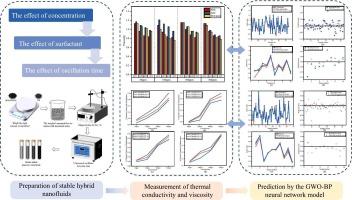Investigation of thermal properties of TiN/MWCNT-OH hybrid nanofluids and GWO-BP neural network model
IF 4.5
2区 工程技术
Q2 ENGINEERING, CHEMICAL
引用次数: 0
Abstract
Hybrid nanofluids have garnered significant attention due to excellent heat transfer performance and potential applications. Conducting comprehensive research on hybrid nanofluids holds paramount importance. This study investigates the effects of surfactants, particle concentrations, mixing ratio and storage time of TiN/MWCNT-OH hybrid nanofluids on stability, thermal conductivity, and viscosity. It proposes a Grey Wolf Optimizer-Backpropagation neural network model for predicting thermal properties. The results indicate that the inclusion of PVP-K30 surfactant leads to remarkable stability of hybrid nanofluids at a concentration of 50 ppm over a period of two weeks. An increase in the proportion of MWCNT-OH results in a slight increase in thermal conductivity, which exhibits a maximum increase of 46 % with elevated temperature and particle concentrations. The viscosity of hybrid nanofluids gradually decreases as temperature rises, although demonstrates a non-linear correlation with concentrations. The neural network model exhibits a high predictive accuracy of 99.3507 % for thermal conductivity and 98.8924 % for viscosity.

TiN/MWCNT-OH 混合纳米流体的热特性研究与 GWO-BP 神经网络模型
混合纳米流体因其优异的传热性能和潜在应用而备受关注。对混合纳米流体进行全面研究至关重要。本研究探讨了 TiN/MWCNT-OH 混合纳米流体的表面活性剂、颗粒浓度、混合比和储存时间对稳定性、热导率和粘度的影响。研究提出了灰狼优化器-反向传播神经网络模型来预测热性能。结果表明,加入 PVP-K30 表面活性剂可使混合纳米流体在浓度为 50 ppm 时在两周内具有显著的稳定性。随着 MWCNT-OH 所占比例的增加,热导率也略有增加,随着温度和颗粒浓度的升高,热导率最大增加了 46%。混合纳米流体的粘度随温度升高而逐渐降低,但与浓度呈非线性关系。神经网络模型的热导率预测准确率高达 99.3507%,粘度预测准确率高达 98.8924%。
本文章由计算机程序翻译,如有差异,请以英文原文为准。
求助全文
约1分钟内获得全文
求助全文
来源期刊

Powder Technology
工程技术-工程:化工
CiteScore
9.90
自引率
15.40%
发文量
1047
审稿时长
46 days
期刊介绍:
Powder Technology is an International Journal on the Science and Technology of Wet and Dry Particulate Systems. Powder Technology publishes papers on all aspects of the formation of particles and their characterisation and on the study of systems containing particulate solids. No limitation is imposed on the size of the particles, which may range from nanometre scale, as in pigments or aerosols, to that of mined or quarried materials. The following list of topics is not intended to be comprehensive, but rather to indicate typical subjects which fall within the scope of the journal's interests:
Formation and synthesis of particles by precipitation and other methods.
Modification of particles by agglomeration, coating, comminution and attrition.
Characterisation of the size, shape, surface area, pore structure and strength of particles and agglomerates (including the origins and effects of inter particle forces).
Packing, failure, flow and permeability of assemblies of particles.
Particle-particle interactions and suspension rheology.
Handling and processing operations such as slurry flow, fluidization, pneumatic conveying.
Interactions between particles and their environment, including delivery of particulate products to the body.
Applications of particle technology in production of pharmaceuticals, chemicals, foods, pigments, structural, and functional materials and in environmental and energy related matters.
For materials-oriented contributions we are looking for articles revealing the effect of particle/powder characteristics (size, morphology and composition, in that order) on material performance or functionality and, ideally, comparison to any industrial standard.
 求助内容:
求助内容: 应助结果提醒方式:
应助结果提醒方式:


